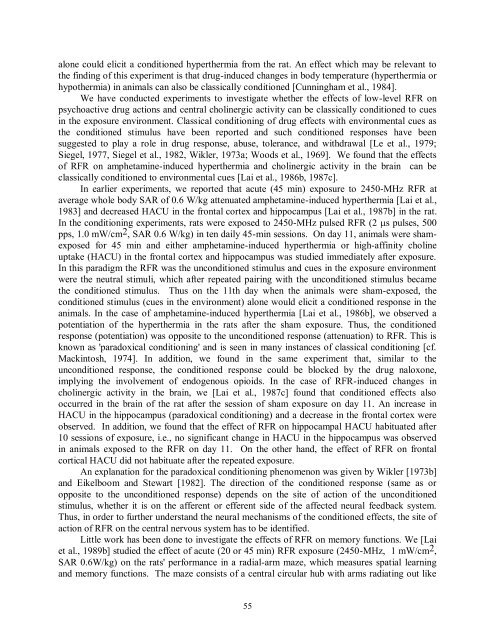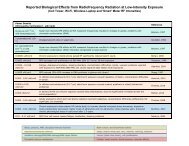Evidence for Effects on Neurology and Behavior - BioInitiative Report
Evidence for Effects on Neurology and Behavior - BioInitiative Report
Evidence for Effects on Neurology and Behavior - BioInitiative Report
You also want an ePaper? Increase the reach of your titles
YUMPU automatically turns print PDFs into web optimized ePapers that Google loves.
al<strong>on</strong>e could elicit a c<strong>on</strong>diti<strong>on</strong>ed hyperthermia from the rat. An effect which may be relevant to<br />
the finding of this experiment is that drug-induced changes in body temperature (hyperthermia or<br />
hypothermia) in animals can also be classically c<strong>on</strong>diti<strong>on</strong>ed [Cunningham et al., 1984].<br />
We have c<strong>on</strong>ducted experiments to investigate whether the effects of low-level RFR <strong>on</strong><br />
psychoactive drug acti<strong>on</strong>s <strong>and</strong> central cholinergic activity can be classically c<strong>on</strong>diti<strong>on</strong>ed to cues<br />
in the exposure envir<strong>on</strong>ment. Classical c<strong>on</strong>diti<strong>on</strong>ing of drug effects with envir<strong>on</strong>mental cues as<br />
the c<strong>on</strong>diti<strong>on</strong>ed stimulus have been reported <strong>and</strong> such c<strong>on</strong>diti<strong>on</strong>ed resp<strong>on</strong>ses have been<br />
suggested to play a role in drug resp<strong>on</strong>se, abuse, tolerance, <strong>and</strong> withdrawal [Le et al., 1979;<br />
Siegel, 1977, Siegel et al., 1982, Wikler, 1973a; Woods et al., 1969]. We found that the effects<br />
of RFR <strong>on</strong> amphetamine-induced hyperthermia <strong>and</strong> cholinergic activity in the brain can be<br />
classically c<strong>on</strong>diti<strong>on</strong>ed to envir<strong>on</strong>mental cues [Lai et al., 1986b, 1987c].<br />
In earlier experiments, we reported that acute (45 min) exposure to 2450-MHz RFR at<br />
average whole body SAR of 0.6 W/kg attenuated amphetamine-induced hyperthermia [Lai et al.,<br />
1983] <strong>and</strong> decreased HACU in the fr<strong>on</strong>tal cortex <strong>and</strong> hippocampus [Lai et al., 1987b] in the rat.<br />
In the c<strong>on</strong>diti<strong>on</strong>ing experiments, rats were exposed to 2450-MHz pulsed RFR (2 s pulses, 500<br />
pps, 1.0 mW/cm 2 , SAR 0.6 W/kg) in ten daily 45-min sessi<strong>on</strong>s. On day 11, animals were shamexposed<br />
<str<strong>on</strong>g>for</str<strong>on</strong>g> 45 min <strong>and</strong> either amphetamine-induced hyperthermia or high-affinity choline<br />
uptake (HACU) in the fr<strong>on</strong>tal cortex <strong>and</strong> hippocampus was studied immediately after exposure.<br />
In this paradigm the RFR was the unc<strong>on</strong>diti<strong>on</strong>ed stimulus <strong>and</strong> cues in the exposure envir<strong>on</strong>ment<br />
were the neutral stimuli, which after repeated pairing with the unc<strong>on</strong>diti<strong>on</strong>ed stimulus became<br />
the c<strong>on</strong>diti<strong>on</strong>ed stimulus. Thus <strong>on</strong> the 11th day when the animals were sham-exposed, the<br />
c<strong>on</strong>diti<strong>on</strong>ed stimulus (cues in the envir<strong>on</strong>ment) al<strong>on</strong>e would elicit a c<strong>on</strong>diti<strong>on</strong>ed resp<strong>on</strong>se in the<br />
animals. In the case of amphetamine-induced hyperthermia [Lai et al., 1986b], we observed a<br />
potentiati<strong>on</strong> of the hyperthermia in the rats after the sham exposure. Thus, the c<strong>on</strong>diti<strong>on</strong>ed<br />
resp<strong>on</strong>se (potentiati<strong>on</strong>) was opposite to the unc<strong>on</strong>diti<strong>on</strong>ed resp<strong>on</strong>se (attenuati<strong>on</strong>) to RFR. This is<br />
known as 'paradoxical c<strong>on</strong>diti<strong>on</strong>ing' <strong>and</strong> is seen in many instances of classical c<strong>on</strong>diti<strong>on</strong>ing [cf.<br />
Mackintosh, 1974]. In additi<strong>on</strong>, we found in the same experiment that, similar to the<br />
unc<strong>on</strong>diti<strong>on</strong>ed resp<strong>on</strong>se, the c<strong>on</strong>diti<strong>on</strong>ed resp<strong>on</strong>se could be blocked by the drug nalox<strong>on</strong>e,<br />
implying the involvement of endogenous opioids. In the case of RFR-induced changes in<br />
cholinergic activity in the brain, we [Lai et al., 1987c] found that c<strong>on</strong>diti<strong>on</strong>ed effects also<br />
occurred in the brain of the rat after the sessi<strong>on</strong> of sham exposure <strong>on</strong> day 11. An increase in<br />
HACU in the hippocampus (paradoxical c<strong>on</strong>diti<strong>on</strong>ing) <strong>and</strong> a decrease in the fr<strong>on</strong>tal cortex were<br />
observed. In additi<strong>on</strong>, we found that the effect of RFR <strong>on</strong> hippocampal HACU habituated after<br />
10 sessi<strong>on</strong>s of exposure, i.e., no significant change in HACU in the hippocampus was observed<br />
in animals exposed to the RFR <strong>on</strong> day 11. On the other h<strong>and</strong>, the effect of RFR <strong>on</strong> fr<strong>on</strong>tal<br />
cortical HACU did not habituate after the repeated exposure.<br />
An explanati<strong>on</strong> <str<strong>on</strong>g>for</str<strong>on</strong>g> the paradoxical c<strong>on</strong>diti<strong>on</strong>ing phenomen<strong>on</strong> was given by Wikler [1973b]<br />
<strong>and</strong> Eikelboom <strong>and</strong> Stewart [1982]. The directi<strong>on</strong> of the c<strong>on</strong>diti<strong>on</strong>ed resp<strong>on</strong>se (same as or<br />
opposite to the unc<strong>on</strong>diti<strong>on</strong>ed resp<strong>on</strong>se) depends <strong>on</strong> the site of acti<strong>on</strong> of the unc<strong>on</strong>diti<strong>on</strong>ed<br />
stimulus, whether it is <strong>on</strong> the afferent or efferent side of the affected neural feedback system.<br />
Thus, in order to further underst<strong>and</strong> the neural mechanisms of the c<strong>on</strong>diti<strong>on</strong>ed effects, the site of<br />
acti<strong>on</strong> of RFR <strong>on</strong> the central nervous system has to be identified.<br />
Little work has been d<strong>on</strong>e to investigate the effects of RFR <strong>on</strong> memory functi<strong>on</strong>s. We [Lai<br />
et al., 1989b] studied the effect of acute (20 or 45 min) RFR exposure (2450-MHz, 1 mW/cm 2 ,<br />
SAR 0.6W/kg) <strong>on</strong> the rats' per<str<strong>on</strong>g>for</str<strong>on</strong>g>mance in a radial-arm maze, which measures spatial learning<br />
<strong>and</strong> memory functi<strong>on</strong>s. The maze c<strong>on</strong>sists of a central circular hub with arms radiating out like<br />
55



